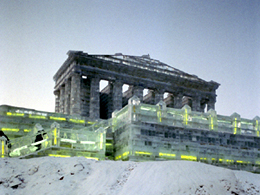COLUMNS
LANDSCAPES

28 February, 2014
Recognising the dimension of time in the landscape
The Archaeologist' s view. Groth in his article "Frameworks, for cultural landscape study" writes for the Americans that "they are like fish that can't see the water" and "although human life requires the constant support of complex surroundings...
Groth in his article "Frameworks, for cultural landscape study" writes for the Americans that "they are like fish that can't see the water" and "although human life requires the constant support of complex surroundings, most people in the United States do not consciously notice their everyday environments". When it comes to the understanding of landscape, we all act in a similar way, we cannot see what is in front of us.
Think for a minute the word "landscape": can you answer to the question "what is a landscape?". It might sound easy but it is not. Landscape is an attractive term, something that brings immediately to our minds a pleasant prospect; it also an ambiguous term used differently in a variety of contents; and, it is an important term it encompasses an ensemble of ordinary factors which constitute an extraordinary rich exhibit of the course and character of any society. There many perspectives on the landscape as there many disciplines using and this plurality of views has brought us to a point that we believe the landscape is a difficult idea to grasp.
Undoubtedly, our relationship with the landscape is an experiential one, and as an experiential process it is composed by two basic elements: space and time. The first has been the object of study for a variety of disciplines and is exemplified through a number of methods of Landscape Character Assessment. The second is left almost undiscovered, as an element that creates a crisis which cannot be resolved. Nevertheless, it is an element not only inscribed on the landscape, but is the very essence of it. It is one of its basic qualities, evolving in a linear mode and simultaneously expressed in a chaotic manner. Landscape elements created in the past in a variety of contexts, receive different meanings throughout the years; they are re-constructed, re-understood, re-communicated and re-disposed. This inevitable reality marks the landscape with a series of chaotic symbolic pathways that distinguish our various relationships with our spatial environment.

The chaotic course of time in space. China 2008. Photographer: Olga Stefatou.

The temporary element in the present, such as this copy of the Acropolis of Athens made on ice, dominates a landscape of the city of Beijing. Space and time are witnessed in a complicated and chaotic relationship. China 2008. Photographer: Olga Stefatou.
Since it is impossible to consider space without involving time, it is imperative to seriously incorporate it in our landscape studies. In order to plan better for the landscapes of the future, we need to appraise their present state through the lenses of their past and their pastness.
by Aphrodite Sorotou
Mediterranean Institute for Nature and Anthropos
Department of Archaeology, University of Glasgow
Special thanks to Dr Goltsiou for her invitation and Ms Olga Stefatou for her photographs
Related reading and references
Council of Europe, The European Landscape Convention, http://www.coe.int/t/dg4/cultureheritage/heritage/landscape/default_en.asp
Groth P. E. and Bressi T. W. (eds), 1997, Understanding Ordinary Landscapes, Yale University Press
Ingold T., 1993, "The temporality of landscape", in World Archaeology, Vol25, No2, Conceptions of Time and Ancient Society, pp. 152-174
Serres M. and Latour B., 1995, Conversations on Science, Culture and Time, University of Michigan Press.
Stefatou, O, 2012, www.olgastefatou.com
Witmore C., 2009α, "Prolegomena to Open Pasts: On Archaeological Memory Practices", in Archaeologies 5:3, pp. 511-545
Witmore C., 2009β, "The Realities of the Past: Archaeology, Object-Orientations, Pragmatology", in B.R. Fortenberry and L. McAtackney (eds), Modern Materials: Proceedings from the Contemporary and Historical Archaeology in Theory Conference, Archaeopress.
Related articles:
- Landscape design for different cultures ( 27 November, 2012 )
- Playgrounds ( 07 November, 2011 )
- New column in greekarchitects by Aikaterini Gkoltsiou ( 06 November, 2011 )
- Green Walls-Vertical Gardens ( 07 December, 2011 )
- Tourist landscapes ( 09 January, 2012 )
- Landscape architecture : hotel renovations ( 09 February, 2012 )
- Mediterranean gardens ( 10 March, 2012 )
- The role of landscape architect in agritourism landscape design ( 12 May, 2012 )
- Ιle Seguin – Rives de Seine ( 25 September, 2012 )
- ΤΑΤΟϊ: Α complete proposal for the protection and enhancement of the former Royal Estate. ( 25 October, 2012 )










